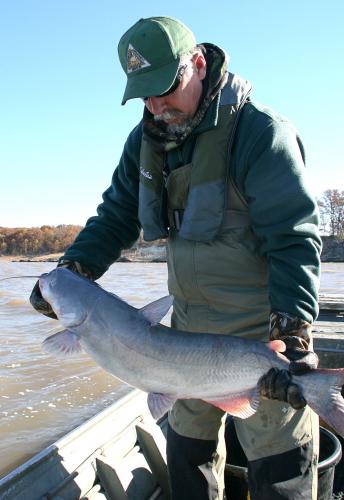
Xplor reconnects kids to nature and helps them find adventure in their own backyard. Free to residents of Missouri.


































Stay in Touch with MDC news, newsletters, events, and manage your subscription

Xplor reconnects kids to nature and helps them find adventure in their own backyard. Free to residents of Missouri.

A monthly publication about conservation in Missouri. Started in 1938, the printed magazine is free to residents of Missouri.


TRUMAN LAKE Mo -- Missouri Department of Conservation (MDC) biologists recently wrapped up the first phase of a new blue catfish survey at Truman Lake and Lake of the Ozarks.
MDC crews used methods typically employed by anglers to catch a representative sample of fish from each lake.
Crews at Truman Lake, led by Fisheries Biologist Mike Bayless and Resource Scientist Zach Ford, concluded their final survey day on Nov. 4. Winds following a cold front sent whitecaps across the Berry Bend area where they hauled in 52 jug lines set on the Osage River arm.
Using hooks baited with cut shad, they landed 17 blues. All fish were measured, weighed, evaluated and released. The information expands the database for a popular sport fish that faces heavy fishing pressure.
“This survey is being conducted in advance of proposed regulation changes,” Bayless said. “We’ll gather data over a three-year period. Then, if our proposed regulation is approved and takes effect, seven or eight years down the line we’ll start another three-year survey so we can determine if the regulation has had the desired positive impact on the blue-cat fishery.”
Anglers can currently keep five blue catfish of any size daily.
A committee of biologists and other MDC staff is proposing a regulation change that would allow each angler to keep 10 blue catfish daily. The current proposal would require that all fish between 25 and 35 inches long, usually 6- to 17-pounds, would have to be released. The proposal calls for allowing one or two fish above the slot to be part of the overall limit.
The goal is to allow more blue catfish to reach their potential larger sizes – 20 to 80 pounds – because big fish are why many anglers target blues with rod and reel, trotlines or jug lines.
Many anglers and biologists are concerned that the numbers of big blue catfish have declined at Truman Lake, and the proposed regulation is designed to reverse that.
“We started hearing concerns from anglers back in the early 1990s,” Bayless said.
Since the regulation change would allow anglers to keep 10 blue catfish, including one or two above the slot limit, anglers would still be able to harvest plenty of fish to eat.
Bayless said that Truman Lake still has large numbers of small blue catfish and reproduction remains strong. He added that growth rates for blues at the lake are slower than normal, which may be due to the large numbers of small catfish.
“Blue catfish are vulnerable to fishing pressure,” he said. "Most blue catfish are being caught before they reach the larger sizes coveted by many catfish fans. They readily take baits and they swim in open waters easily accessible to anglers."
An MDC survey at the lake from 2003 to 2008 utilized reward tags placed on blue catfish. Anglers were paid $50 for reporting the tags. The study showed that for blue catfish 24 inches or larger, 92 percent were caught within the five-year period.
Angler harvest rates in the study were two-to-three-times higher than similar catfish studies nationwide.
In a 2002 catfish-angler survey by the MDC, the largest percentage of anglers responding said the Truman Lake fishery had declined.
Bayless explained that the MDC is proposing the slot limit to restore more large blue catfish in Truman Lake. The same regulation is proposed for Lake of the Ozarks to keep that catfish fishery from declining.
The MDC's Regulations Committee reviews such proposals. Pending that review, it would then be presented to the Department director and then to the Missouri Conservation Commission, which sets regulations.
MDC biologists began gathering blue catfish data this fall to have more reference information. But because the fish grow slowly it will take some years before results can be measured, Bayless said.
A similar survey was conducted this fall at Lake of the Ozarks by Fisheries Management Biologist Greg Stoner and Fisheries Resource Technician Clark Foster and crews.
“We wanted to use methods for the survey that are like what many fishermen use,” Bayless said. “And we wanted to be able to catch fish of all sizes.”